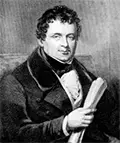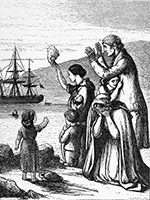Ireland from the U.K. to Republic
The Act of Union 1800 created the United Kingdom of Great Britain and Ireland. As part of the negotiations surrounding that amalgamation, the British Government had agreed to repeal the Test Act, which required allegiance to the Church of England for anyone who wished to hold public office, civil or military. The 1678 Act was the third in a series of such acts that reinforced the supremacy of the Church of England and, effectively also reinforced the disenfranchised members of the Catholic faith. This was intended to entice Ireland to join the United Kingdom. It wasn't just Catholicism that was an "other" religion at this time; people in Great Britain and Ireland also were Baptists or Presbyterians or any of a handful of other faiths. The number of Catholics was still sizable in England and very high in Ireland. Although Prime Minister William Pitt the Younger championed the Test Act repeal, King George III indicated that he would not give his royal assent and so Parliament did not enact the repeal; Pitt resigned in protest, but his successor, Henry Addington, was unable to succeed where Pitt had not. Parliament had passed the Roman Catholic Relief Act 1791, which allowed Catholics to pursue professions that previously been off limits to them (like education and the law) and also allowed them to vote if they were holders of land of a certain annual rental value. Another element in this regard was the decision of the British Army in 1811 (at the height of the Napoleonic Wars) to give Catholic soldiers the right to practice their faith openly while in the military service. 
In 1823, an Irish lawyer named Daniel O'Connell established the Catholic Association, with the goal of Catholic Emancipation, meaning the complete freedom of Catholics to be treated just like any other citizens of the United Kingdom. He won election to Parliament in County Clare in 1828 but, by law, could not take his seat in Parliament. That was a special election. He won the normal election the following year and was again unable to sit in Parliament. Opposition to Catholic Emancipation was still strong in the House of Lords. As well, the king (who by this time was George IV) still opposed it, as did the two leading politicians of the 1820s, Sir Robert Peel and the Duke of Wellington. Public opinion was strongly in favor of emancipation, and the issue had strong support in the House of Commons as well. Parliament in 1828 passed the Sacramental Test Act, removing the requirement for civil servants to belong to the Church of England. The Roman Catholic Relief Act of 1829 was the final step in the process, repealing the Test Act, removing all Penal Laws, and doing away with all other restrictions on Catholics. O'Connell and his Catholic Association had all but threatened insurrection; and Peel, who had previously served as chief secretary for Ireland, guided the bill through passage in the Commons. After that, Wellington persuaded a majority in the House of Lords to pass the bill and then (by threatening to resign as Prime Minister) persuaded the king to give his Royal Assent. O'Connell then took his seat in Parliament.
The lawyer-turned-lawmaker O'Connell then became a symbol and supporter of the repeal of the Act of Union. He had a number of allies in this drive to emancipate Ireland entirely from Great Britain. Charles Duffy and Thomas Davis in 1842 founded the Nation newspaper to provide the voice for the growing Young Ireland movement. More and more Irish people join O'Connell and others at large public demonstrations to promote the Free Ireland cause. These demonstrations were peaceful; the only thing angry was the words. However, Parliament got wind of a really large demonstration planned for October 1843 at Clontarf, site of the battle won by Brian Boru against the Vikings in 1014. The Irish nationalist Robert Emmet had led a violent uprising in 1803 that resulted in the killing of the Lord Chief Justice of Ireland. Emmet had been convicted of treason and then publicly executed. Subsequent protests had been largely peaceful, but the British Government wasn't taking any chances, especially since the 1843 demonstration was to take place at such a highly symbolic place. Then-Prime Minister Peel sent troops and cannons to help police keep the peace. O'Connell called off the demonstration, but he and other leaders of the Young Ireland movement were arrested anyway and then tried and convicted of seditious conspiracy and thrown in prison. The House of Lords overturned the convictions in 1844, after the men had served several months in prison. Many in Ireland wanted to continue the peaceful fight for emancipation, but the failure of the potato crop in 1845 changed priorities for nearly everyone in the country.
The potato came to be a staple of Irish agriculture, producing large harvests in the predominantly damp climate while requiring relatively little work to plant or harvest. Estimates are that by 1840, as many as one-third of the Irish population considered the potato as the primary source of food. In September 1845, the arrival of the potato blight changed Irish civilization. It was a tiny fungus called Phytophthora infestans. Striking quickly and savagely, the blight killed off one-third of the Irish potato crop in a year and three-quarters of the remaining crop in each of the next two years. People who couldn't afford to plant or eat much else struggled with starvation and disease. A great many died. Historians differ on the total number of deaths during the Great Potato Famine. Conservative estimates number 500,000; some accounts number the dead at 1.5 million. Another 1 million are thought to have fled the country, many going to America and Canada. In 1848, a series of uprisings took place in Europe. The Revolutions of 1848 resulted in the ouster of two monarchs, France's King Louis-Philippe and Austria's Emperor Ferdinand I, and of Austria's Chancellor Klemens von Metternich, as well as the devolution from monarchy into constitutional monarchy for a handful of other countries. No such action took place in England or Scotland, but some members of the Young Ireland movement staged a raucous protest in Ireland that led a decade later to the formation of the Irish Republican Brotherhood (IRB), also known as the Fenians. The leader of this organization from its start was James Stephens. The IRB organized a large uprising in 1867; it was not violent, and English authorities did not carry out reprisals against the organizers. Another lawyer, Isaac Butt, in 1870 founded the Irish Home Government Association, which proved successful at putting into the U.K. House of Commons a number of Members of Parliament (MPs) who wanted an independent Ireland. Eventually taking over the leadership of this organization was Charles Stewart Parnell. A preferred tactic of the MPs was to actively obstruct the proceeds when Parliament in session. The revolutionary Michael Davitt founded the Land League in 1879. Davitt, recently released from prison after serving time for running guns and other weapons, wanted a more powerful solution to the problem of Irish underrepresentation in land ownership, and he urged Irish people who owned small plots of land to rise up in defiance of the English owners of large areas of land. The Land League had in 1882 organized the killing of Lord Frederick Cavendish, the Irish chief secretary, and his undersecretary. Parnell assumed leadership of the group and disowned such violence. He had as his goals for the peasantry the Three F's: fixity of tenure, fair rent, and freedom to sell the land they owned. The Land League did have some successes: Land acts in 1881 and 1903 forced land sales and created fair rents. Next page > A Desire for Home Rule > Page 1, 2, 3 |
|
Social Studies for Kids
copyright 2002–2024
David White






